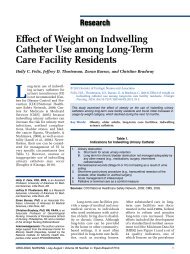You also want an ePaper? Increase the reach of your titles
YUMPU automatically turns print PDFs into web optimized ePapers that Google loves.
SERIESrelated to knowledge of comfortableand complete pelvic examination,normal and abnormalpelvic anatomy and function, pessaryindications and risks, andmanagement of complications.Written material and educationaldiagrams related to pelvicanatomy, pelvic floor dysfunctions,and specific pessary placementand care enhance patientteaching and should be availableonsite and in take-home format.Whenever possible, all materialshould be available in languagesthat meet the needs of womenseeking outpatient care. A samplepessary handout is presented inFigure 3. When women receiveboth manufacturer and providercare instructions, any discrepanciesshould be ex plained. Otheruseful educational handoutsinclude summaries of relatedtreatment options, such as vaginalestrogens, anticholinergicmedications, urethral bulkingagents, and/or vaginal moisturizersand acidification products.General equipment neededto provide pessary care includesmany items already present in awomen’s health setting, such asvaginal specula, proctologyswabs, straight catheters, lubricants,examination gloves, anditems for assessment of vaginaldischarge (such as pH paper,microscopy, cultures) and urine(such as containers and dipsticks).Cotton-tip applicators orcytology brushes are useful forcleaning pessary drainage holes.Items specific to pessary careinclude selected pessaries and/orfitting kits, written informationand anatomic diagrams, items forvaginal lavage (such as saline,provodine iodine, 10 to 60 ccsyringe), and an autoclave oralternate cleaning and sterilizationplan. A small storage cart onwheels may be useful for transportingequipment to variousexamination rooms (see Figure4). In addition, the office maywish to stock other pessary-relateditems, such as tubes of acidifyinggel (Trimosan TM ).Figure 3.Sample Patient Handout – <strong>Pessary</strong> Care InstructionsWhy do I need a pessary?A pessary is a silicone support device used to support the vagina in womenwho have prolapse (dropping of the pelvic organs) or some kind of urine loss.Pessaries come in many sizes, shapes, and variations. For example, some aredesigned for self-removal, but some are not; some can be worn during sexualintercourse; some will only stay in place if a woman still has strong vaginalmuscles. A pessary can be a comfortable, safe way for many women to controlpelvic problems for a short time or for years.How often does a pessary need to be removed for cleaning?This varies. Some women remove their pessary every night and put it backin the next morning, others remove their pessary occasionally or to have sex,while others only have their pessary removed at an office visit every few months.The best plan for you depends on the type of pessary that works for you and whatyou prefer. Even if you remove and clean your own pessary, you still need to beseen regularly for follow-up care because pessaries can cause painless butserious pressure sores in the vagina.How do I care for my own pessary?If you have a pessary, you can remove it easily and then replace yourself, orwe will work with you in the office to be sure you can:• Remove your pessary.• Wash it with warm water and soap.• Rinse it well.• Reinsert your pessary, often with a special cream we may prescribe.Your pessary is called a ________________________________ pessary, size___________.• To Insert: Wash your hands,lubricate your vagina. Wash/dry yourhands again. Fold the pessary.Insert.• To remove: Wash your hands. Insertone finger into your vagina. Hookyour finger through the finger hole,loop, or above the top of the pessary,and pull out and downwards.What should I expect if I use a pessary?While you use a pessary, you should be seen regularly to be sure thepessary is not causing painless sores in your vagina. Between visits, call if younotice any changes, especially pain, bleeding, increasing odor, or problemspassing your urine or bowels. At each visit, your pessary will be removed andcleaned, your vagina will be examined for irritation, and if everything is okay, yourpessary will be reinserted. Here is our plan for your care.[Insert your plan of care.]Do I need any creams or treatments?We may advise you to use a vaginal estrogen with your pessary. Thesepreparations can be an important way to prevent infection and injury becausethey can increase blood supply and elasticity. This may also make pessaryremoval and insertion more comfortable. Other treatments, such as a gel calledTrimosan ® , can make the vagina more pH-balanced (acidic), and decrease riskof odor or infection. DO NOT use petroleum jelly (Vaseline ® ) or other oil-basedlubricants with your pessary.If you have problems or questions, please call us any time at [insert yourcontact plan].SPECIAL SERIES ON PESSARIESUROLOGIC NURSING / May-June 2012 / Volume 32 Number 3 141
















